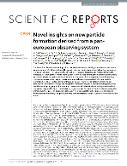Novel insights on new particle formation derived from a pan-european observing system

Autor
Dall'Osto, M.
Beddows, D. C. S.
Asmi, A.
Poulain, L.
Hao, L.
Freney, E.
Allan, J. D.
Canagaratna, M.
Crippa, M.
Bianchi, F.
de Leeuw, G.
Eriksson, A.
Swietlicki, E.
Hansson, H. C.
Henzing, J. S.
Granier, C.
Laj, P.
Onasch, T.
Prevot, A.
Putaud, J. P.
Sellegri, K.
Vidal, M.
Virtanen, A.
Simo, R.
Worsnop, D.
O'Dowd, C.
Kulmala, M.
Harrison, Roy M.
Datum vydání
2018Publikováno v
Scientific ReportsRočník / Číslo vydání
2018 (8)ISBN / ISSN
ISSN: 2045-2322Metadata
Zobrazit celý záznamKolekce
Tato publikace má vydavatelskou verzi s DOI 10.1038/s41598-017-17343-9
Abstrakt
The formation of new atmospheric particles involves an initial step forming stable clusters less than a nanometre in size (<similar to 1 nm), followed by growth into quasi-stable aerosol particles a few nanometres (similar to 1-10 nm) and larger (>similar to 10 nm). Although at times, the same species can be responsible for both processes, it is thought that more generally each step comprises differing chemical contributors. Here, we present a novel analysis of measurements from a unique multi-station ground-based observing system which reveals new insights into continental-scale patterns associated with new particle formation. Statistical cluster analysis of this unique 2-year multi-station dataset comprising size distribution and chemical composition reveals that across Europe, there are different major seasonal trends depending on geographical location, concomitant with diversity in nucleating species while it seems that the growth phase is dominated by organic aerosol formation. The diversity and seasonality of these events requires an advanced observing system to elucidate the key processes and species driving particle formation, along with detecting continental scale changes in aerosol formation into the future.
Klíčová slova
aerosol mass-spectrometer, positive matrix factorization, volatile organic-compounds, cloud condensation nuclei, sulfuric-acid, air-quality, size distributions, biogenic emissions, atmospheric nucleation, chemical-composition
Trvalý odkaz
https://hdl.handle.net/20.500.14178/2298Licence
Licence pro užití plného textu výsledku: Creative Commons Uveďte původ 4.0 International






